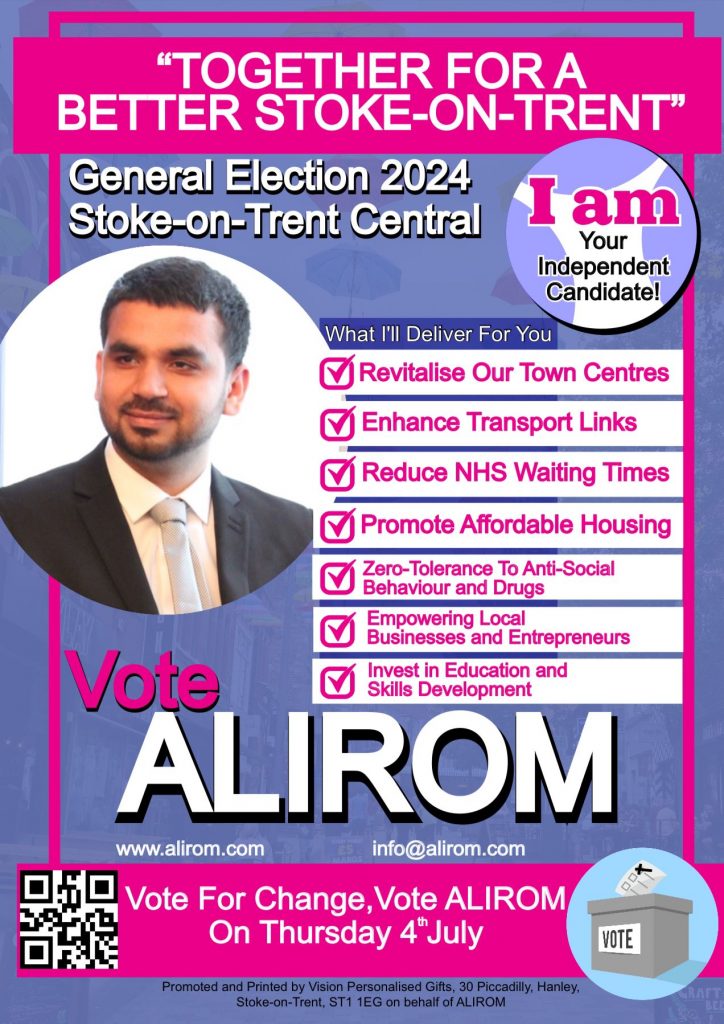Stoke-on-Trent, a city in Staffordshire, England, has a rich political history spanning over a century. Here are some key milestones and developments in its political landscape:
Early 20th Century:
1910s-1920s: Stoke-on-Trent was formally granted city status in 1925, having been formed from the six towns of Burslem, Fenton, Hanley, Longton, Stoke, and Tunstall. The area was primarily an industrial hub, known for its pottery industry, which shaped its early political concerns and affiliations.
Interwar Period:
1920s-1930s: The Labour Party started gaining traction, reflecting the working-class population’s needs and concerns. The decline of traditional industries, including the pottery sector, led to significant economic challenges, which influenced local politics.
Post-World War II:
1940s-1950s: Post-war, the Labour Party dominated, focusing on rebuilding and addressing the housing crisis. Social welfare policies were pivotal, aligning with national Labour government policies of the time.
1960s-1970s:
- 1960s: The city continued to face industrial decline, leading to economic and social challenges. Labour maintained a strong presence, but there was growing discontent and calls for diversification of the economy.
- 1970s: Economic difficulties persisted, with significant impacts from the national economic crises of the decade. This period saw occasional Conservative gains but Labour retained overall dominance.
1980s-1990s:
- 1980s: The era of Thatcherism saw significant political shifts. The Conservative Party’s policies on industrial relations and economic reforms were contentious, particularly in industrial areas like Stoke-on-Trent. Labour continued to be strong, reflecting local opposition to many Conservative policies.
- 1990s: Labour’s dominance was reinforced by the broader national shift against the Conservatives, culminating in the landslide victory of Tony Blair’s New Labour in 1997. Locally, there was a focus on regeneration and modernisation efforts.
2000s:
- 2000s: Stoke-on-Trent faced ongoing challenges with economic regeneration and social issues. Labour’s stronghold began to waver slightly with growing support for alternative parties, including the Liberal Democrats and, later, UKIP.
- Mid-2000s: The city experienced significant political turbulence, with frequent changes in political leadership and control of the city council.
2010s:
- 2010-2015: The rise of UKIP reflected broader national trends, capitalising on discontent with traditional parties. The Labour Party still held significant influence but faced challenges from both UKIP and the Conservatives.
- 2016: The Brexit referendum was a pivotal moment, with Stoke-on-Trent voting heavily in favour of leaving the EU, which significantly influenced subsequent political dynamics.
- Late 2010s: The political landscape saw further shifts with the resurgence of the Conservatives, who began to make significant inroads, capitalising on Brexit sentiments.
2020s:
2020-Present: The political environment remains dynamic, with ongoing debates about economic regeneration, housing, healthcare, and education. The 2019 general election saw the Conservatives winning multiple seats in the area, reflecting a broader national trend.
Key Political Figures:
- Josiah Wedgwood IV: A notable figure in the early 20th century, serving as a Liberal MP and later as a Labour MP after crossing the floor.
- Jack Ashley: A Labour MP from 1966 to 1992, known for his advocacy for disabled people.
- Tristram Hunt: Labour MP from 2010 to 2017, who later became the director of the Victoria and Albert Museum.
Conclusion:
Stoke-on-Trent’s political history is marked by its industrial roots, predominantly Labour influence, and recent shifts towards more diverse political representation. The city’s evolving economic and social landscape continues to shape its political dynamics.

